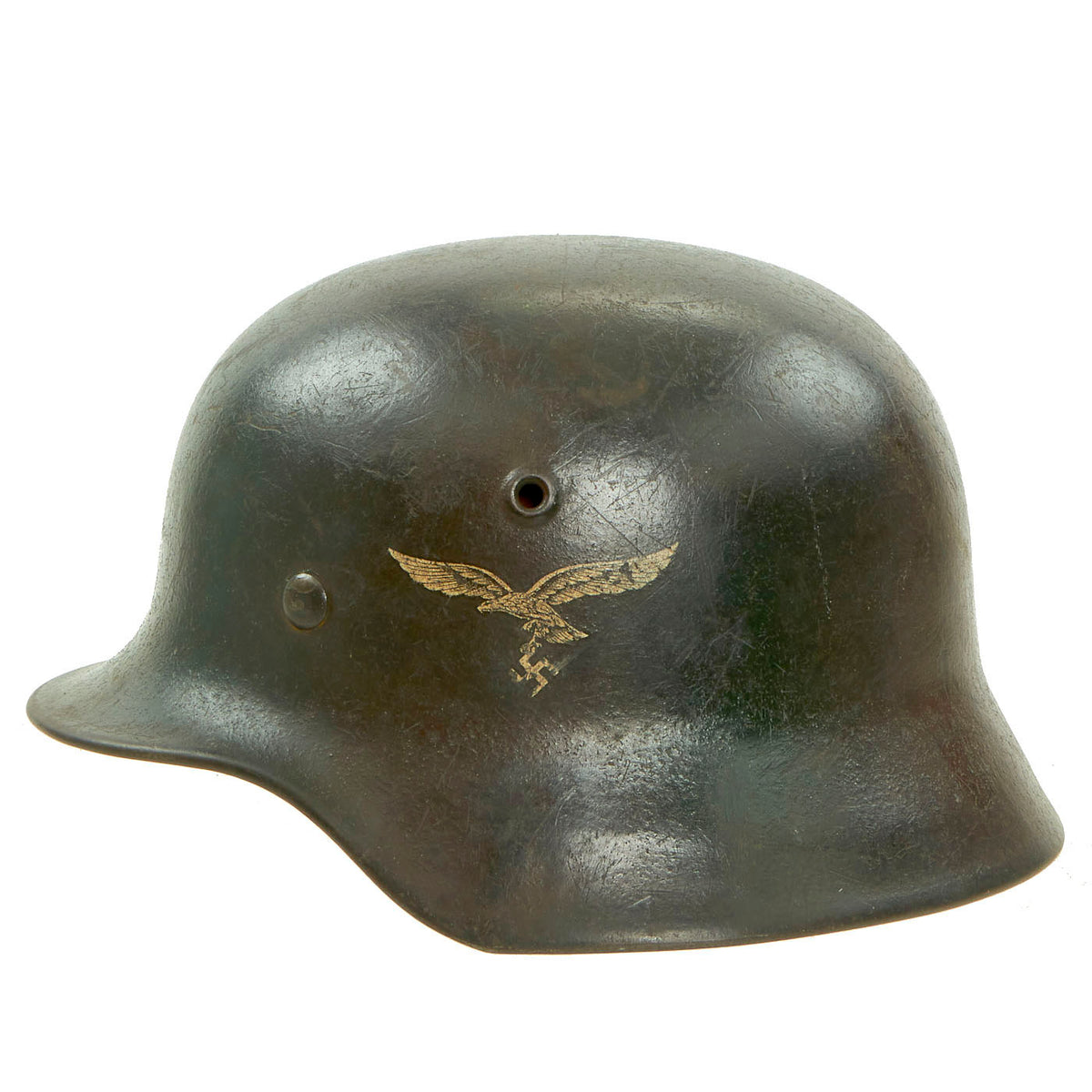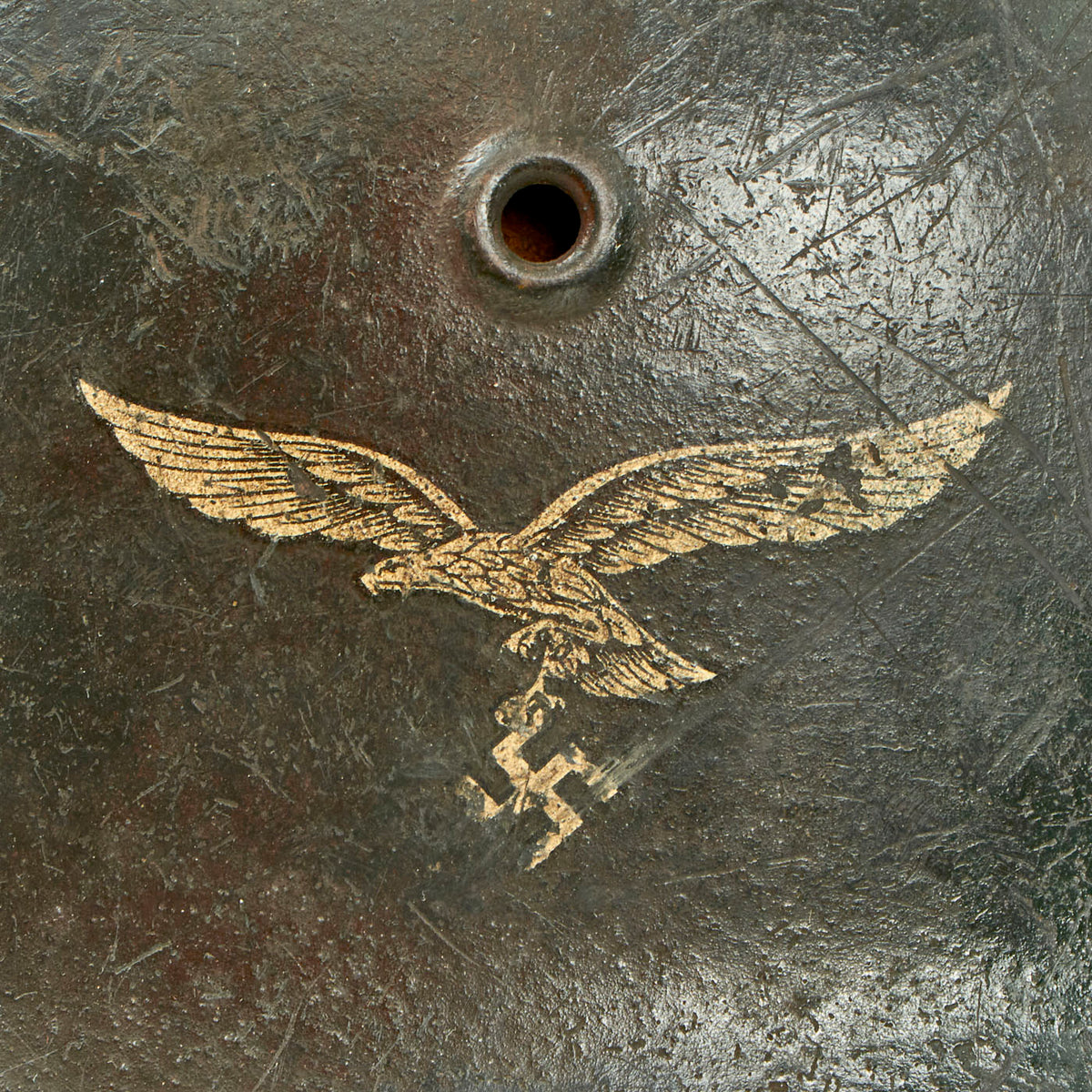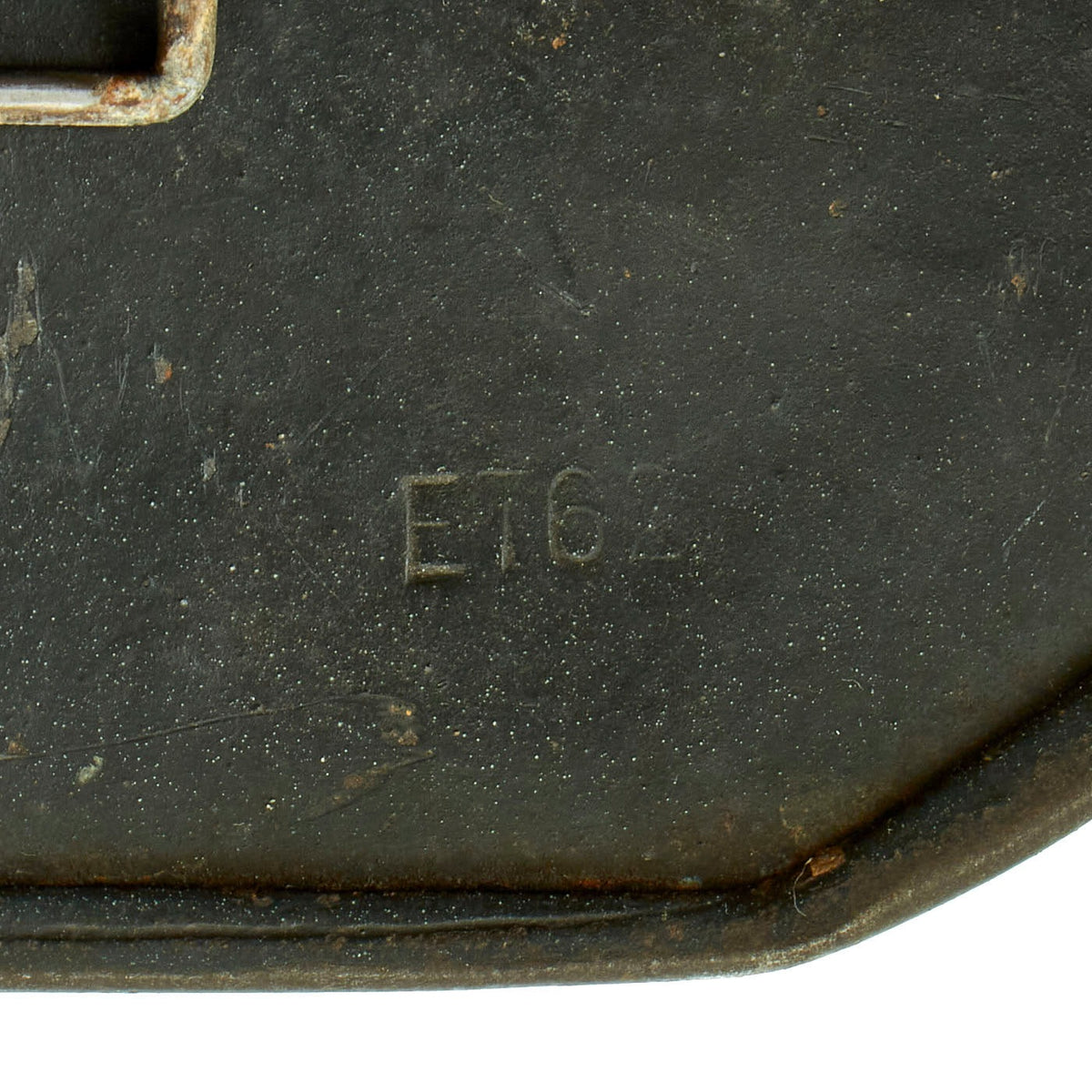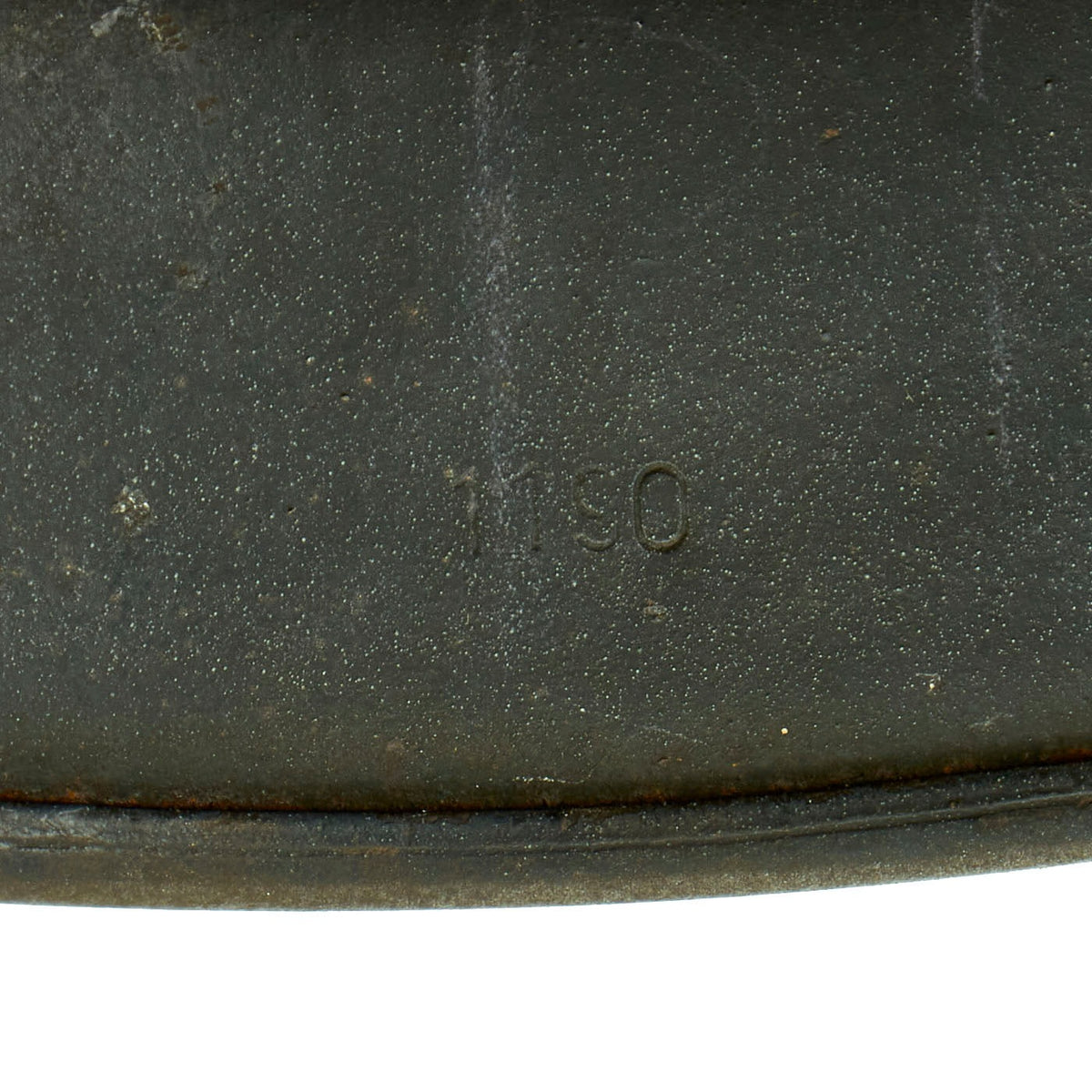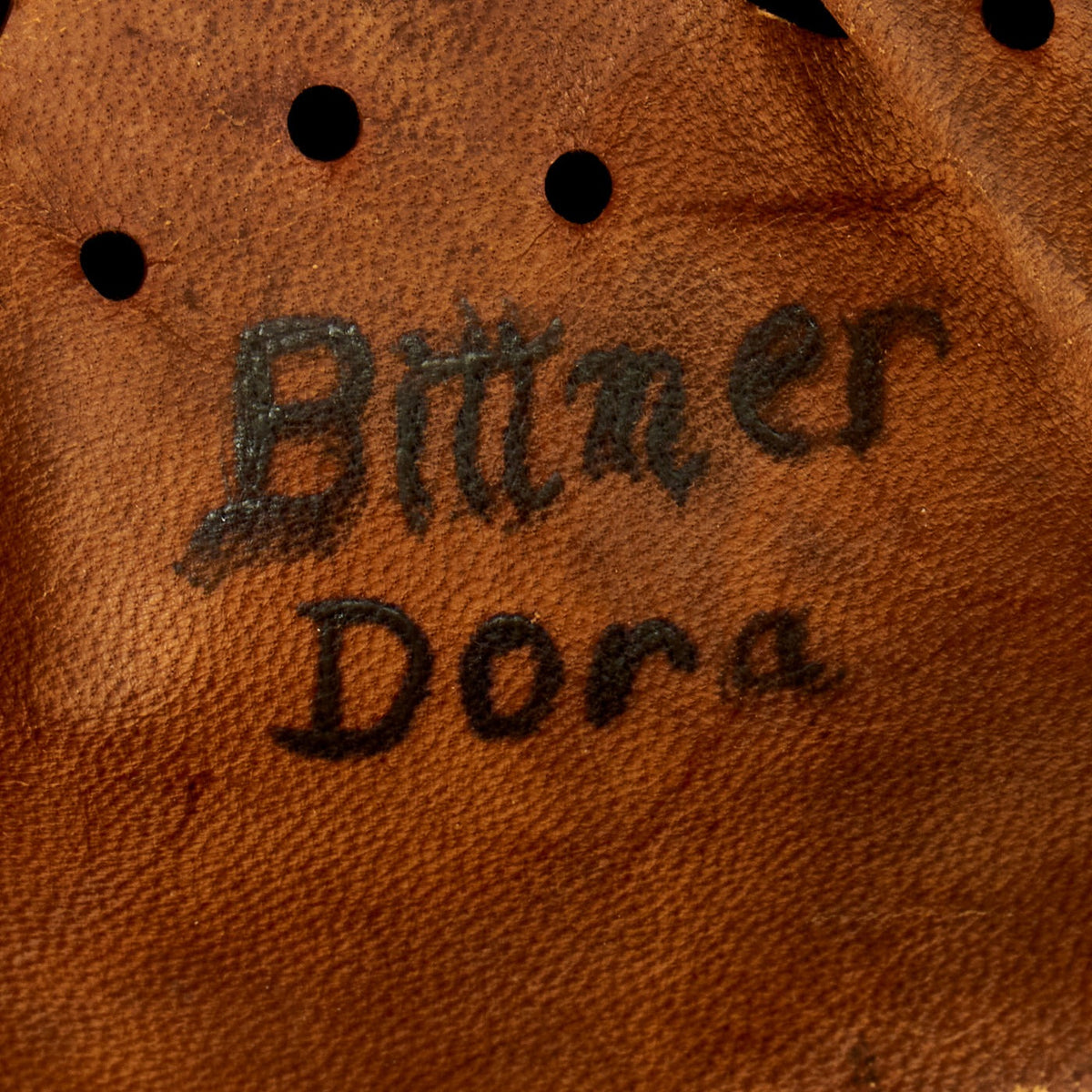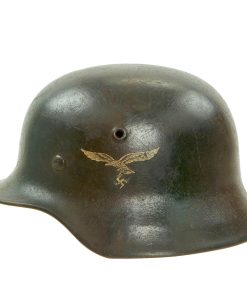Original German WWII Luftwaffe Single Decal Three-Color Camouflage Overpaint M40 Helmet- 1942 Dated – ET62 Original Items
$ 1.695,00 $ 423,75
Original Item: One-of-a-kind. This is what we all look for and can never find; an incredible 100% authentic Single Decal Three-Color Camouflage Overpaint Model 1940 German Luftwaffe Helmet! This helmet was just located “out of the woodwork” in Pennsylvania, and is fresh to the collector market, having been located in the same house for the last 70+ years.
Original German camouflage painted helmets have become increasingly hard to locate in recent years. This stunning example has had the original grey-blue Luftwaffe factory paint overpainted with Dark Green and Ochre Reddish Brown Paint. Interestingly, a decal was reapplied over the camouflage, which is not usually the norm, but was somewhat common during the period if extra decals were available. The camouflage pattern is very subtle, and does just enough to break the silhouette of the helmet. In the correct light, the colors of the helmet really “pop” for lack of a better term. This is a handsome, and completely untouched helmet, offered just as found!
This stamped sheet steel construction helmet retains much of its original Normandy Camo paint but shows expected wear and use. It is retained about 85%, with the worn off areas showing the original Luftwaffe blue paint. The left side of the helmet features a Luftwaffe eagle decal which was painted over, while the right side has a National Colors shield. The decals can be both seen and felt beneath the paint, and even a bit of the red from the national shield can be seen.
All three liner retaining pins are intact, and retain most of their camouflage paint. The interior of the helmet still has the original M31 leather liner with all eight of its fingers intact. The liner retains its original leather finish, having never had oils or preservatives applied. The liner is in overall good solid condition and not stiff, with even the original rayon drawstring in the crown intact. . The liner is size stamped 55, and the early war aluminum liner band is dated 1942 over the left ear. The liner is named “Bittner/Dora” in Germanic script in the liner.
The reverse, interior, neck guard apron is batch number stamped, 1190 and the interior, left side, apron has a stamped manufacturer’s code and size, ET62. Unfortunately the original chinstrap is missing, but one could easily be obtained if one so desired.
A fantastic “fresh-to-the-market” find! These helmets do not come on the market often that are in this nice, righteous, untouched condition!
German Camouflaged Helmets
One effective, although more permanent method of concealing the helmet was the use of camouflage paint. It is up to some debate exactly when this method began among German soldiers but by the time of the Normandy campaign it was widespread. In mid 1943 the German high command ordered that a three color camouflaged scheme of tan, green and brown be used in the painting of vehicles and other equipment. These same paints were used to camouflage helmets as well. While the high command did order specific color codes be used for consistency, the hues of tan, green, and brown can vary on original examples significantly. The mix of these tan, green, and brown colors were used by German troops at Normandy with such frequency that today collectors call almost any German helmet with a mix of these three colors “Normandy Camo”. It should be clear that while the use of these three colors for camouflaging helmets was common, there was never a directive from the German military high command to paint helmets in this manor. No officially sanctioned “Normandy camo” existed. The collector term, ”Normandy Camo” can still be justified to a large degree. Photos from the battle as well as surviving original example with Normandy providence would indicate this particular camo pattern was a favorite of Germans during the campaign. The mix of the three colors was certainly a good choice for Normandy as the countryside does exhibit those same colors. That being said with much of Western Europe’s terrain looking so similar this same pattern would see action in other battles as well. The camouflage paints used at Normandy do not confine themselves to distinct hues of tan, brown and green. Some helmets were painted with two colors or just one and sometimes with non-standard military paints that were probably locally sourced. Further complicating the matter, captured British, Soviet, French and Italian paints were all used to camouflage helmets at Normandy. The hue of these colors often deviate from the standard German military colors. The German soldiers who camouflaged their helmets were well aware of their surroundings and certainly were aware of what colors and patterns would blend into the terrain they would soon be fighting in. It is logical they would have chosen colored paint based the local area which would account for the variation.
The German Helmet:
The first “modern” steel helmets were introduced by the French army in early 1915 and were shortly followed by the British army later that year. With plans on the drawing board, experimental helmets in the field, (“Gaede” helmet), and some captured French and British helmets the German army began tests for their own steel helmet at the Kummersdorf Proving Grounds in November, and in the field in December 1915. An acceptable pattern was developed and approved and production began at Eisen-und Hüttenwerke, AG Thale/Harz, (Iron and Foundry Works), in the spring of 1916.
These first modern M16 helmets evolved into the M18 helmets by the end of WWI. The M16 and M18 helmets remained in usage through-out the Weimar Reichswehr, (National Defence Force, Circa 1919-1933), era and on into the early years of the Third Reich until the development of the smaller, lighter M35 style helmet in June 1935.
In 1934 tests began on an improved Stahlhelm, whose design was a development of World War I models. The Eisenhüttenwerke company of Thale carried out prototype design and testing, with Dr. Friedrich Schwerd once again taking a hand.
The new helmet was pressed from sheets of molybdenum steel in several stages. The size of the flared visor and skirt was reduced, and the large projecting lugs for the obsolete armor shield were eliminated. The ventilator holes were retained, but were set in smaller hollow rivets mounted to the helmet’s shell. The edges of the shell were rolled over, creating a smooth edge along the helmet. Finally, a completely new leather suspension, or liner, was incorporated that greatly improved the helmet’s safety, adjustability, and comfort for each wearer. These improvements made the new M1935 helmet lighter, more compact, and more comfortable to wear than the previous designs.
The Army’s Supreme Command officially accepted the new helmet on June 25, 1935 and it was intended to replace all other helmets in service.
The M1935 design was slightly modified in 1940 to simplify its construction, the manufacturing process now incorporating more automated stamping methods. The principal change was to stamp the ventilator hole mounts directly onto the shell, rather than utilizing separate fittings. In other respects, the M1940 helmet was identical to the M1935. The Germans still referred to the M1940 as the M1935, while the M1940 designation were given by collectors.
Fast Shipping with Professional Packaging
Thanks to our longstanding association with UPS FedEx DHL, and other major international carriers, we are able to provide a range of shipping options. Our warehouse staff is expertly trained and will wrap your products according to our exact and precise specifications. Prior to shipping, your goods will be thoroughly examined and securely secured. We ship to thousands clients each day across multiple countries. This shows how we're dedicated to be the largest retailer on the internet. Warehouses and distribution centres can be located throughout Europe as well as the USA.
Note: Orders with more than one item will be assigned a processing date depending on the item.
Before shipping before shipping, we'll conduct a thorough inspection of the items you have ordered. Today, the majority of orders will be delivered within 48 hours. The delivery time will be between 3-7 days.
Returns
The stock is dynamic and we cannot completely manage it because multiple stakeholders are involved, including our factory and warehouse. So the actual stock may alter at any time. It's possible that you may not receive your order once the order has been made.
Our policy is valid for a period of 30 days. If you don't receive the product within 30 days, we are not able to issue a refund or an exchange.
You can only return an item if it is unused and in the same state as the day you received it. You must have the item in its original packaging.
Related products
Uncategorized
Australian WWII Owen MK1 Machine Carbine SMG Custom Fabricated Replica with Sling Original Items
Uncategorized
Uncategorized
Uncategorized
Band of Brothers ORIGINAL GERMAN WWII Le. F.H. 18 10.5cm ARTILLERY PIECE Original Items
Uncategorized
Armored Burgonet Helmet & Polearm from Scottish Castle Leith Hall Circa 1700 Original Items
Uncategorized
Uncategorized
Uncategorized
Angolan Rebel 1970s era 60mm Inert Display Mortar from Angolan Civil War Original Items
Uncategorized
Uncategorized
Uncategorized
Uncategorized
Armoured Fighting Vehicles of the World: AFVs of World War One (Hardcover Book) New Made Items
Uncategorized
Uncategorized
Uncategorized
Uncategorized
Uncategorized
Uncategorized
Uncategorized
Uncategorized
Uncategorized
